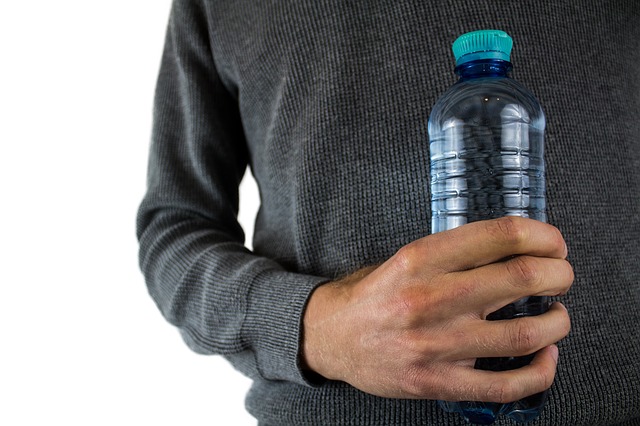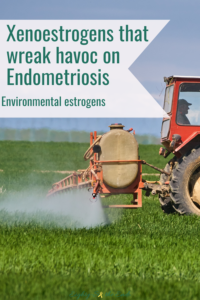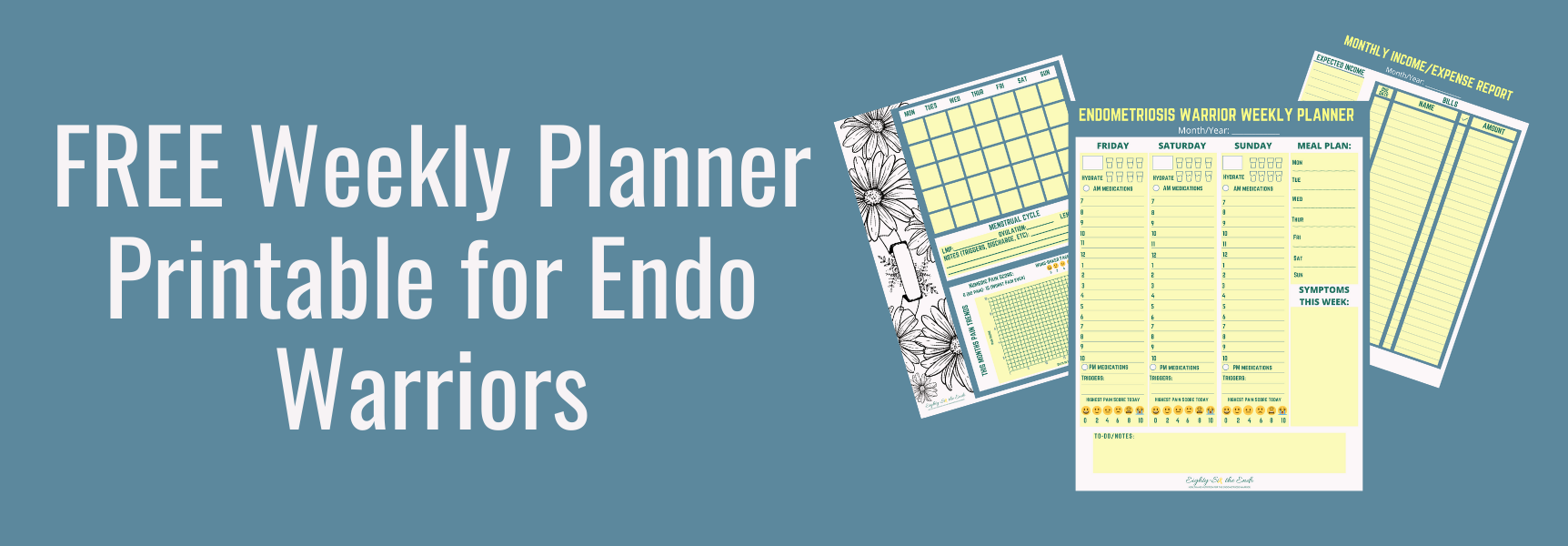Xenoestrogens are almost impossible to avoid. What’s important is that you minimize your exposure to these toxins that can negatively affect endometriosis
With endometriosis being so misunderstood by conventional medicine, I find myself clinging to the things that medical literature has deemed significant to the development and progression of this horrible condition. At this point, there is clear evidence that endometriosis is affected by hormones, with estrogen being the main culptrit.
In this article, I will review the many xenoestrogens that can be associated with endometriosis and other associated diagnoses, like infertility.
What is a Xenoestrogen?
Simply put, a xenoestrogen is an environmental estrogen. They are part of a larger category of endocrine disrupting chemicals (i.e. chemicals that interfere with normal hormonal processes). More specifically, they are chemical compounds that interfere with estrogen receptors in the body.
Essentially, decreasing your exposure to environmental estrogens can play a key role in the managing your endo. And although it is nearly impossible to eliminate exposure to all environmental toxins, conscientious endo warriors can still find ways to avoid them.
But in order to do so, you must recognize where they are found so that you can make an informed decision when it comes to your chemical burden and exposure.
Important Xenoestrogens To Avoid
Dioxins
Dioxins are by-products made from the manufacturing of chlorine bleach, paper pulp and pesticides; they eventually contribute to environmental pollution.
The US Environmental Protection Agency estimates more than 95% of dioxin exposure comes from our food, with animal products being the largest culprit (5). This includes dairy, meat, fish, chicken, and shellfish (1).
But how does this relate to endometriosis? There is evidence suggesting that dioxins are associated with increased chances of endometriosis (5).
But even if you decide to change your diet, dioxin exposure is still possible as it is not limited to our food.
One study found trace amounts of dioxins present in 4 different tampons evaluated (5). However, the study also notes that the dioxin exposure from tampons in not nearly as significant when compared to other sources of dioxins (5).
However, pathologists like Dr. Philip Tierno, of NYU, believe that trace amounts of dioxin exposure from tampons can have long term progressive effects (7).
Think about it . . . tampons sit within tissues that can easily absorb trace amounts of dioxin. And as a woman struggling with infertility, I question if my 15+ years of tampon use has played a role in my ability to concieve (or maybe I’m just paranoid).
In the end, more studies need to be done. And I’m not the only one who thinks so!
US House Representative Carolyn Maloney has put forth the “Robin Danielson Feminine Hygiene Product Safety Act of 2017” which calls for a dedicated program to the research of dioxins and other contaminates in hygiene products (6). #girlpower
Disclosure: This post may contain affiliate links. I earn from qualifying purchases. This comes at no extra cost to you and I only recommend products that I believe will be valuable to my audience.
How To Reduce Dioxin Exposure
For one, decrease your daily consumption of animal products. Incorporating more plant-based meals into your diet can decrease your overall dioxin exposure, especially if you purchase organic produce; but more on that later.
Secondly, consider using unbleached organic cotton tampons or opt for reusable products like menstrual cups and washable cotton cloth pads.
I personally have just switched to using the Diva Cup, and although I’m still navigating the transition, I definitely feel it was the right decision for me. Ultimately, you must decide what you are comfortable with.

BPA (bisphenol A)
It is very likely that you have heard this acronym being thrown around in recent articles, studies, and marketing advertisements; for good reason too!
BPA, or Bisphenol-A, is a toxic man-made compound used in plastics and epoxy resins (4).
Unfortunately, BPA is all around us, even in household dust (4). But most notably, it can be found in the lining of canned foods and plastic food ware.
In fact, one study showed that people who ate canned soups for 5 days straight had urine BPA levels that increased by one hundred percent (4). This terrifies me, as I used to always buy canned goods in an effort to shorten my time in the kitchen.
But what exactly does BPA have to do with Endo?
The chemical structure of BPA is very similar to that of estradiol, a hormone produced by the ovaries. It’s similar structure allows it to attach to cellular targets, making it a known xenoestrogen and endocrine disruptor (4). This, in turn, can have long term effects on fertility and can increase the chances of endometriosis (4).
Currently there are no human studies that can claim a direct correlation between BPA and human infertility; I mean, who would want to voluntarily sign up for that study?
There are, however, animal studies that show BPA can cause disruption of early oocyte formation and increased chances of Polycystic Ovarian Syndrome.

In the human studies that have been done, researchers found notable conclusions when they looked at the levels of BPA found in blood and urine. Here is what they found (4):
- Men have decreased sperm motility
- Increased likelihood of endometriosis
- Increases in implantation failure
- Decreased ovarian response
- Decrease in blastocyte formation (precursor to embryo formation)
- Recurrent miscarriage
So, if you are struggling with infertility and/or endometriosis, it is vital that you do whatever you can to decrease your BPA exposure.
How To Decrease Your BPA Exposure
The most obvious intervention is to purchase a reusable water bottle that is BPA and PFC free (more on PFC’s later). There are many plastic reusable bottles that claim to be BPA free, but I find that the safest option is to opt for a glass water bottle with a silicon sleeve.
Secondly, when grocery shopping for canned goods, look for non-BPA lined cans. I have found this to be almost always present for organic canned goods, but conventional canned goods also have this option.
Lastly, you may be surprised to know that BPA is used in receipt paper (1). For this reason, if you have the option to receive your receipt by email, then I encourage you to do so. And if you feel that your purchase does not require a receipt, then it is okay to decline it.

Pesticides
Pesticides- the term itself makes me cringe. Literally used to kill pests/bugs, it only seems logically that we should not expose ourselves to pesticides. But the reality is that agricultural practices frequently rely on pesticides.
Unfortunately, increased pesticide levels in the blood have been associated with higher chances of an endometriosis diagnosis (2).
The government has statutes that regulate the amount of pesticides that can be safely sold to the consumer, but it’s easy to forget about the “cocktail effect” that happens when we have multiple foods in any given meal (3).
Some pesticides have a synergistic effect with other chemical pesticides; which means that the toxicity of each pesticide is enhanced when it is combined with the other (3). This is why it’s so important that we take into consideration the places by which our food is sourced.
How To Decrease Your Pesticide Exposure
Maybe you shouldn’t be discounting the importance of buying organic produce.
Yup, I went there! The USDA has strict standards on foods that have the organic stamp of approval; one of them being that no synthetic pesticides, herbicides, or fertilizers may be used.
But in all honesty, even I do not have the income to support an all organic lifestyle. So, if you are in a similar boat, then maybe focus your organic efforts on the Dirty Dozen (8).
The Dirty Dozen is a list created by The Environmental Working Group. It sheds light on the top thirteen foods that a consumer should buy organic due to the high pesticide concentration found in tested samples. So really, it’s a baker’s dozen! Among these foods are (8):
- Strawberries
- Spinach
- Nectarines
- Apples
- Grapes
- Peaches
- Cherries
- Pears
- Tomatoes
- Celery
- Potatoes
- Sweet Bell Peppers
- Hot Peppers

PFC’s
Perfluorinated Chemicals, or PFC’s, are endocrine disrupting chemicals that are most frequently used to increase water resistance and decrease the chances of sticking or staining.
For this reason, PFC’s are commonly found on cookware, in water bottles, on furniture/mattresses, or in beauty products.
PFC’s are currently being studied extensively for their effect on human health. At this point, there are animal studies that show PFC’s can poorly affect the endocrine system, the immune system, and vital body organs like the pancreas and liver (9).
Additionally, it was shown to produce delays in development when animals were exposed in the womb (9).
How To Reduce PFC Exposure
Although there is always room for more studies, we are already seeing a shift in the market. Many cookware companies are creating non-toxic, PFC-free cookware, which ensures that toxic fumes are not being absorbed into the foods we eat/cook.
I have taken advantage of this change by purchasing a ceramic cookware set from Greenlife, which I love!! Ceramic cookware is great, as it provides a nonstick surface without the use of PFC’s. Stainless steel and cast-iron cookware are also safe alternatives.
Opting for natural, vegan, and eco-friendly products can also help you minimize your PFC exposure. But keep in mind that not all “natural” products are PFC free. Read your labels and look for these avoidable names (9):
- Perfluorobutane sulfonate
- Perfluorohexane sulfonate
- Perfluorohexanoic acid
- Perfluorooctanoic acid
- Perfluorooctane sulfonate
- Perfluorononanoic acid
- Perfluorodecanoic acid
- 8+2 Fluorotelomer alcohol

More Xenoestrogens to Consider
- Perchlorate: Found in body care items, fragrances, and fireworks (1)
- Fire Retardant: Found in polyurethane foam, mattresses, & home goods (1)
- Lead: Found in paint, toys, and public water (1)
- Arsenic: Found in food and public water (1)
- Mercury: Found in contaminated fish and wildlife (1)
Xenoestrogens: Key Take Away
As you can see, xenoestrogens are in abundance and almost impossible to avoid. What’s important is that you remember the goal, which is to minimize your exposure to these environmental toxins that can exacerbate the development of endometriosis.
All in all, when purchasing items for your kitchen and home, take note of their source and manufacturing process. You can significantly impact your long term health just by becoming mindful of your environment and the products you introduce to your body.
Let me know if this was helpful to you by commenting below! Share with me how you will be decreasing your exposure to xenoestrogens!

- Cohn, S.M., Cohn, P., & Zalace, A. (Producers), & Cohn, S.M. (Director). (2016). Endo What? [Motion picture]. USA: Endo What LLC.
- Smarr, M. M. Kannan, K. & Buck Louis, G. M. (2016). Endocrine disrupting chemicals and endometriosis. Fertility and Sterility, 106(4), 959-966. Retrieved from https://www.clinicalkey.com/#!/content/playContent/1-s2.0-S0015028216613894?returnurl=null&referrer=null
- Shaw, I. C. (2014), Chemical residues, food additives and natural toxicants in food – the cocktail effect. International Journal of Food Science + Technology, 49, 2149-2157. doi:10.1111/ijfs.12606
- Mileva, G., Baker, S. L., Konkle, A. T., & Bielajew, C. (2014). Bisphenol-A: Epigenetic Reprogramming and Effects on Reproduction and Behavior. International Journal of Environmental Research and Public Health, 11(7), 7537-7561. https://doi.org/10.3390/ijerph110707537
- DeVito, M. J., & Schecter, A. (2002). Exposure assessment to dioxins from the use of tampons and diapers. Environmental health perspectives, 110(1), 23-8. doi: 10.1289/ehp.0211023
- R. 2379 Robin Danielson Feminine Hygiene Product Safety Act of 2017. (2017). Retrieved from https://www.congress.gov/bill/115th-congress/house-bill/2379/text
- Dudley, S., Nassar, S., Hartman, E., Wang, S. (2019). Tampon Safety. National Center for Health Research. Retrieved from http://www.center4research.org/tampon-safety/
- Environmental Working Group (2018). Dirty Dozen: EWG’s 2018 Shopper’s Guide to Pesticides in Produce [webpage]. Retrieved from https://www.ewg.org/foodnews/dirty-dozen.php
- NIH (2016). Perfluorinated Chemicals [PDF]. Retrieved from https://www.niehs.nih.gov/health/materials/perflourinated_chemicals_508.pdf



